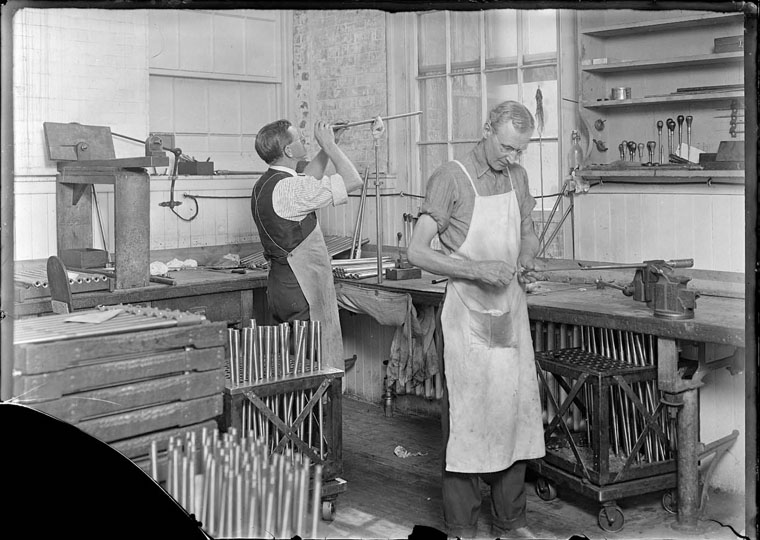There were
few labor disputes of enough importance to provoke collective action
by workers at Springfield Armory. Instead, the workers seemed to take into their
stride the complications of piece rates, varying hours, and changes in management,
to say nothing of the fluctuations in scale of production between the times
of peace and war.1

Two Armory workers star gauging rifles to inspect the rifling of the barrel
After the Civil War, the armorers found themselves in a growing category of
federal government employees, which was subject to across-the-board Congressional
action that did not always suit the local conditions of work at the Armory, such
as the law limiting working hours to eight a day. The armorers somehow managed
in the 1880s to get an exception allowed so they could work ten hours a day.
A channel of conflict resolution open to armorers was by way of political influence
in Washington and involved the direct intervention of local congressmen responsive
to the petitions of civilian Armory workers in their Congressional district.
Superintendents and workers alike perceived Congressional political interest
as setting limits to superintendents' scope of control over armory procedures.
Armory correspondence in mid-summer 1892 shows that the Congressional channel
was still functioning: when Armory workers in Springfield suspected that
the "customary" two-week closing of the shops at the end of the fiscal
year for inventory and clean-up would be followed by a major reduction in
the workforce or work hours, they told their local Congressman, who promptly
wrote to the Chief of Ordnance about it, who in turn wrote to the Armory superintendent,
Colonel Mordecai, for explanation. Similarly, when the practice of piece-work
was threatened by provisions of the 1915 and 1916 appropriations acts, an
exception was made by the Controller General – surely not against the desire
of the Armory workers – to allow the type of piece-work prevalent at Springfield.
By this time, however, a tentative move toward a labor organization of more
usual and less ad hoc type had begun at the Armory: the 1912 Annual Report
of the Chief of Ordnance took note of the recently provided lunchroom as a meeting
place for two unnamed associations of workmen. It was not until the early
1930s, however, that a union was actually named--the National Federation of Federal
Employees, local #101, -- and it was small and inconsequential. Following the
revelation in 1937 of widespread worker dissatisfaction with wages, workers formed
a new union, Lodge 431 of the American Federation of Government Employees (AFGE),
which differed from most other American Federation of Labor units in being
organized on industrial rather than trade lines. Any civilian employee could
join, and it resisted attempts by trade unions (e.g. electricians) to move in,
by arguing against splitting the ranks of the workers. As mentioned above, this
union succeeded in getting an employee representative to accompany the investigations
of the wage board that conducted a general wage survey and obtained increases
for some 45 jobs by June 1939.
1 Excerpted from CONSERVATIVE
INNOVATORS AND MILITARY SMALL ARMS: AN INDUSTRIAL HISTORY OF THE SPRINGFIELD
ARMORY, 1794-1968, prepared for US NPS by Michael S. Raber, Patrick M. Malone,
Robert B. Gordon, and Carolyn C. Cooper, August 1989.
|